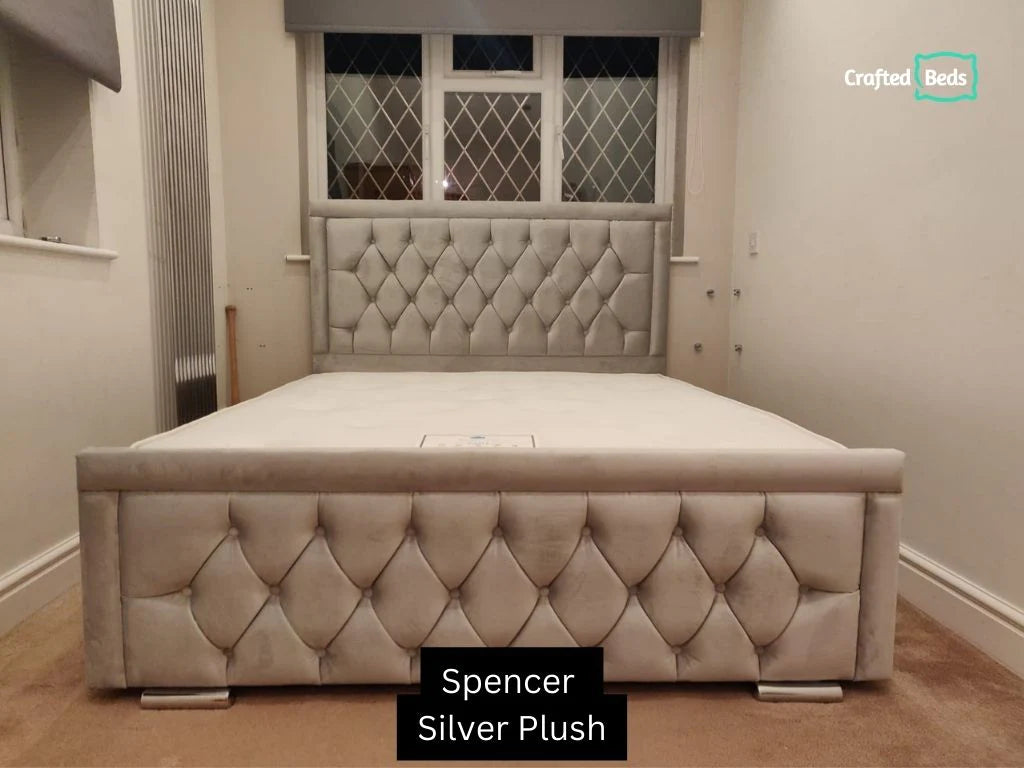You're probably wondering which type of mattress is best for you- an orthopaedic or memory foam mattress. With all of the conflicting information out there, it can be hard to make a decision. Do you go for the tried and true orthopaedic mattress or gamble on the newer memory foam technology?
We're here to help. In "orthopaedic mattress vs memory foam mattress: the buying guide", we'll compare and contrast orthopaedic and memory foam mattresses to help you decide the best fit for your needs.
We'll discuss everything from price to comfort to durability so that you can decide which type of mattress is right for you. So without further ado, let's get started.
What Is an Orthopaedic Mattress?
An orthopaedic mattress is a bed specifically designed to support the skeletal system and relieve pressure points. Unlike regular mattresses, made of soft materials like cotton or foam, orthopaedic mattresses are usually made of firmer materials like latex. This helps to distribute body weight evenly, preventing pressure points from forming and relieving pain in the back, neck, and shoulders. Whether you’re dealing with chronic pain or simply want a better night’s sleep, an orthopaedic mattress may be the perfect solution.
Types of Orthopaedic Mattresses
The term "orthopedic mattress" can describe any type of mattress. However, latex mattresses, hybrid foam, and pocket sprung mattresses are the most popular for relieving pain and good night's sleep.
Latex Mattresses:
A latex mattress is a firmer mattress made of natural or synthetic latex. Latex mattresses are known for their durability and maximum support. In addition, latex mattresses are often resistant to dust mites and other allergens. However, latex mattresses can be quite expensive.
Hybrid Mattresses:
A hybrid mattress is a medium-firm mattress that combines springs and foam. Hybrid mattresses are often more affordable than latex mattresses, but they can't provide the same level of support.
Pocket Sprung Mattress
A pocket sprung mattress is an orthopaedic mattress with pocket springs individually wrapped in fabric pockets. Pocket sprung mattresses are known for their support and durability. In addition, pocket sprung mattresses often have a longer lifespan than other types of mattresses.
Benefits of an Orthopaedic Mattress
Here is the list of Benefits of an Orthopaedic Mattress:
Relieves Pain:
An orthopaedic mattress is specifically designed to support the spine and joints. This mattress can help relieve pain by providing a firm surface for the body to rest on. In addition, an orthopaedic mattress can help keep the spine in alignment, reducing inflammation and improving overall comfort. Many people who suffer from back pain or arthritis find that an orthopaedic mattress helps to alleviate their symptoms.
Promotes Healing:
When you remain in one position for an extended period of time, it can result in stiffness, aches, and even pain. This is especially true if you are recovering from an injury or surgery. An orthopaedic mattress is designed to provide support and promote healing.
The firm surface helps to reduce pressure on the injured area, while the pocket springs provide gentle cushioning. As a result, you can remain comfortable while your body heals. In addition, an orthopaedic mattress can also improve your overall sleep quality by reducing tosses and turns. As a result, you will wake up feeling rested and refreshed, which can further promote healing.
Relieves Stress:
An orthopaedic mattress can also help to relieve stress. The firm surface helps evenly distribute your body weight, which takes the pressure off your muscles and joints. In addition, the springs in an orthopaedic mattress provide gentle cushioning, which can absorb impact and reduce stress on the body. As a result, you can feel more relaxed and rested after a night of sleep on an orthopaedic mattress.
Healthier Blood Circulation:
An orthopaedic mattress is designed to support the spine and joints, which can help improve blood circulation. Because the body is supported in a more natural position, the muscles and tissues are less likely to become cramped or constricted. This can lead to better blood flow and reduced inflammation.
In addition, an orthopaedic mattress is a firm mattress that can help relieve pressure on the spine and joints, improving blood circulation. By providing support and alignment for the spine, an orthopaedic mattress can help to reduce stress on the cardiovascular system. As a result, orthopaedic mattresses can positively impact overall health by improving blood circulation.
Drawbacks of Orthopaedic Mattresses
There are a few potential drawbacks of orthopaedic mattresses to be aware of:
They Can Be Heavy and Difficult to Move:
Orthopaedic mattresses are usually much heavier than other types of mattresses. As a result, they can be difficult to move, especially if you live in a small space. If you think you need to move your orthopaedic mattress frequently, you may want to consider a different type of mattress.
They May Not Be Suitable for Side Sleepers:
Orthopaedic mattresses are designed to provide support for the spine and joints. As a result, they are often quite firm mattresses. If you are a side sleeper, you may find that an orthopaedic mattress is too hard and uncomfortable. In this case, you may want to consider a memory foam mattress.
Overall, orthopaedic mattresses are a wise investment for your health. They can provide support and promote healing while also improving blood circulation. However, orthopaedic mattresses can be expensive and may not be suitable for everyone. If you are considering an orthopaedic mattress, consider all the potential drawbacks before making a purchase.
Now let's discuss Memory foam mattresses:
What Is a Memory Foam Mattress?
A memory foam mattress is an innovative type of bedding that contours to the body to provide support and pressure relief. Memory foam is a viscoelastic material that NASA originally developed to improve safety during aeroplane crashes. The material comprises millions of tiny cells that change shape when they come into contact with heat, such as the heat generated by a person's body.
When you lie down on a memory foam mattress, the cells compress and mould to your specific contours, providing support for your spine and hips. The material then slowly returns to its original shape once you get up. Memory foam mattresses are available in various firmness levels to suit different sleepers, and they can be an excellent option for people with back pain or other chronic pain conditions.
Types of Memory Foam Mattresses
There are a few different types of memory foam mattresses on the market, each with its benefits. So, let's discuss it all in detail:
Traditional Memory Foam
Traditional memory foam is made from a substance called viscoelastic. Viscoelastic is a type of material that is both viscous and elastic. It can mould your body's shape while still providing support.
The result is a mattress that contours to your body, providing customized support. Memory foam is also known for its ability to absorb impact. This makes it an ideal choice for people who suffer from chronic back pain, as it can help to reduce pressure points and relieve pain.
Plant-Based Memory Foam
As the name suggests, this memory foam is made with plant-based ingredients rather than petroleum-based polyurethane. Plant-based memory foam often has a lighter feel and is more responsive than traditional memory foam. It also tends to be more temperature neutral, so it's a good option if you tend to sleep hot.
Another benefit of plant-based memory foam is that it's more environmentally friendly than traditional memory foam. In addition to being more environmentally friendly, plant-based memory foam is less likely to cause allergic reactions and is naturally resistant to dust mites.
Gel-Infused Memory Foam
Gel-infused memory foam mattresses are designed to provide a cooler night's sleep. The gel helps to dissipate heat, making them ideal for people who tend to sleep hot. In addition, gel-infused memory foam mattresses often have a more responsive feel, making them a good choice for people who want a mattress that contours to their body but doesn't make them feel like they're sinking into quicksand.
Benefits of a Memory Foam Mattress
There are many benefits of sleeping on a memory foam mattress, including the following:
Contours to the Body
A memory foam mattress can offer many benefits over a traditional spring mattress. One of the most important benefits is that it contours to the body, providing support where it is needed and relieving pressure points. This can lead to a more comfortable sleep and can help to reduce tossing and turning. Moreover, memory foam mattresses are typically much easier to move and set up than spring mattresses, making them a good choice for those looking for a hassle-free sleeping experience.
Reduces Motion Transfer
Memory foam mattress also reduces motion transfer. This means that sharing your bed with a partner makes you less likely to be disturbed by their movements during the night. Memory foam is highly effective at absorbing energy, which helps reduce the amount of movement transferred from one person to another.
As a result, you can enjoy a more restful night's sleep on a memory foam mattress. In addition, memory foam can help improve blood circulation and promote healing by reducing the pressure on the skin.
Relieves Pressure Points
When you sleep on a memory foam mattress, you are getting the support of traditional mattresses with the added benefits of pressure point relief. The human body has pressure points, where most of your weight is concentrated when lying down.
These pressure points can cause discomfort and even pain if they are not properly supported. Memory foam mattresses are designed to contour your body, supporting pressure points. As a result, you can sleep more comfortably and wake up feeling refreshed and without pain.
Reduces Back Pain
Anyone who has ever suffered back pain knows how debilitating it can be. Even simple tasks like getting out of bed or sitting in a chair can be excruciating. Improving your sleeping surface is one way to help reduce back pain. Memory foam mattresses are an ideal option for many people because they conform to the body, providing support where it is needed most.
Improves Blood Circulation
When you sleep on a traditional mattress, you often end up with pressure points restricting blood flow. This can lead to morning aches and pains, fatigue, and general muscle stiffness.
However, memory foam mattresses evenly distribute weight and minimize the formation of pressure points. This allows for better blood circulation throughout the night, resulting in less pain and stiffness in the morning. In addition, memory foam mattresses are also known for providing relief from conditions like arthritis and fibromyalgia. A memory foam mattress is a good option if you suffer back and joint pain.
Hypoallergenic
Memory foam mattresses are also hypoallergenic, making them a good choice for people with allergies or sensitivities. Memory foam is made of polyurethane, which is a type of plastic. As a result, it does not harbour dust mites or other allergens that can trigger reactions in some people. If you suffer from allergies, a memory foam mattress can help you sleep more comfortably and may even reduce your symptoms.
Reduces Tossing and Turning
Another benefit of memory foam mattresses is that they reduce tossing and turning. This is because memory foam contours the body, providing support and reducing pressure points. As a result, you are less likely to toss and turn in your sleep, leading to a more restful night's sleep. In addition, memory foam mattresses are also known for reducing snoring. By supporting the head and neck, memory foam can help keep the airway open and reduce vibration, leading to snoring.
Drawbacks of Memory Foam Mattress
You should be aware of a few potential drawbacks to memory foam mattresses.
They Are More Expensive Than Traditional Mattresses
Memory foam mattresses generally cost more than traditional mattresses. This is because they are made of higher quality materials and offer superior comfort and support. However, memory foam mattresses provide better support than traditional mattresses so they may be a good investment in the long run.
They Can Be Hot to Sleep On
Another potential drawback of memory foam mattresses is that they can retain heat. This can make them hot to sleep on, especially during summer. To address this issue, many manufacturers now offer gel-infused memory foam mattresses specifically designed to be cooler. You can also look for a mattress with a gel or cooling layer to help keep you cool and comfortable during the night.
They Have a Strong Smell When First Opened
A memory foam mattress may have a strong chemical smell when you first open it. This is because the foams used in memory foam mattresses are manufactured with chemicals. The smell should dissipate within a few days, but if you are sensitive to smells, you may want to choose another type of mattress.
Despite these potential drawbacks, memory foam mattresses offer many benefits that make them a good choice for many people. If you are looking for a comfortable, supportive mattress.
Differences Between Orthopaedic and Memory Foam Mattresses
Both orthopaedic and memory foam mattresses have several similarities. They are both designed to provide support and improve sleep quality. However, there are some key differences between the two types of mattresses, such as firmness level and comfort.
Orthopaedic mattresses are designed to provide support for the spine and joints. Doctors often recommend them for people with back pain or other medical conditions. Orthopaedic mattresses are usually firmer than memory foam mattresses and may not be as comfortable.
Memory foam mattresses are designed to contour the body and reduce pressure points. People with back pain or arthritis often use them. Memory foam mattresses are usually softer than orthopaedic mattresses and may be more comfortable.
Choosing the right mattress is a personal decision. You should consult your doctor before choosing a mattress if you have back pain or other medical conditions. Otherwise, you can try both types of mattresses to see which one is more comfortable for you.
Which Type of Mattress Is Better for You?
There is no simple answer to this question. It depends on your individual needs and preferences. Here are some key points to consider when choosing a mattress:
If You Have Back Pain
If you have back pain, you may want to choose a memory foam mattress. Memory foam mattresses contour the body and reduce pressure points. This can help relieve back pain and improve sleep quality.
If You Are a Side Sleeper
If you are a side sleeper, you may want to choose also choose memory mattress. Memory foam mattresses can provide extra support for the hips and shoulders, which can help prevent pain in these areas.
If You Are Pregnant
If you are pregnant, you may want to choose an orthopaedic mattress. Orthopaedic mattresses are designed to provide support for the spine and joints. This can help relieve pain in the back and other body areas.
If You Are a Stomach Sleeper
If you are a stomach sleeper, you may want to choose an orthopaedic mattress. Orthopaedic mattresses are designed to provide support for the spine and joints. This can help prevent pain in the back and other body areas.
If You Have Joint Pain
If you have joint pain, you may want to choose an orthopaedic foam mattress. Orthopaedic mattresses are designed to provide support for the spine and joints. This can help relieve pain in the back and other body areas.
How to Choose the Best Mattress Between Memory Foam and Orthopaedic Mattresses?
When deciding between memory foam and orthopaedic mattresses, consider the following factors:
Price:
Memory foam mattresses tend to be more expensive than orthopaedic mattresses. An orthopaedic mattress may be a better option if you're on a budget.
Comfort:
Memory foam conforms to your body, providing support and pressure relief. Orthopaedic mattresses are firm and provide support for your spine. An orthopaedic mattress may be a better choice if you suffer from joint pain. However, memory foam may be a better option if you want a softer mattress and relief back pain.
Durability:
Both memory foam and orthopaedic mattresses are durable. However, memory foam may start to sag over time. An orthopaedic mattress may be the better choice if you want a mattress that will last for years.
Temperature Control:
Memory foam retains heat and can sleep hot. An orthopaedic mattress may be a better choice if you tend to sleep hot or live in a hot climate. However, memory foam may be better if you like being enveloped by your mattress.
Motion Transfer:
Memory foam minimizes motion transfer, so if you sleep with a partner, memory foam may be a better choice. However, an orthopaedic mattress may be a better choice if you tend to move around during the night or want an extra-firm mattress.
Now that you know the key differences between memory foam and orthopaedic mattresses, you can decide correct mattress according to your needs. Consider your budget, comfort preferences, and other factors to find the perfect mattress.
Where to Buy Best Orthopaedic and Memory Foam Mattress?
Now hopefully, you understand the key differences between an orthopaedic mattress and a memory foam mattress. And also, you know which one will be the best fit for you according to your sleep needs and preferences.
Because, in this buying guide, we have introduced you to the benefits of both an orthopaedic mattress and a memory foam mattress, as well as the differences between them. We have also provided guidance on which type of mattress is best for various sleeping positions and medical conditions. We have shared some tips on how to choose the best mattress for your needs.
If you are ready to make a purchase, Craftedbeds are a great option. At craftedbeds, we specialize in orthopaedic mattresses and memory foam mattresses that provide maximum support, weight distribution, spinal alignment, blood circulation, and comfort. Our products are made with only the highest quality materials and construction techniques so that you can get the most out of your sleep.
So, If you are looking for a new mattress or want to upgrade your current one, be sure to check out our selection of orthopaedic mattresses and memory foam mattresses today!
FAQs
Is Orthopedic Mattress Same as Memory Foam?
No, orthopedic and memory foam mattresses are not the same. Orthopaedic mattresses are designed to provide support for the spine and joints, while memory foam mattresses conform to your body and provide pressure relief.
Why Should You Not Buy a Memory Foam Mattress?
Memory foam mattresses can sleep hot and retain heat. An orthopaedic mattress may be a better choice if you live in a hot climate or tend to sleep hot. But, nowadays, many manufacturers have developed new memory foam technology that helps regulate body temperature.
Are Orthopaedic Mattresses Worth It?
Yes, Orthopedic mattresses are designed to support the spine and joints. An orthopaedic mattress may be a better choice if you suffer from back or joint pain.
What Is an Orthopedic Memory Mattress?
An orthopaedic memory mattress is a type of mattress that combines the features of an orthopaedic mattress and a memory foam mattress. An orthopaedic memory mattress supports the spine and joints while conforming to your body and providing pressure relief.
How Often Should You Replace Your Mattress?
You should replace your mattress every 7-10 years. However, if you have back pain or other health issues, or your mattress has been filled with holes, you may need to replace your mattress sooner.





